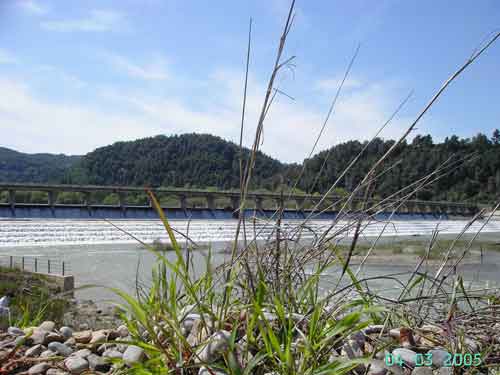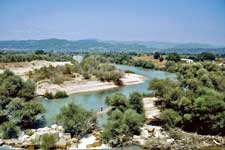.

Alfeios River, Image Sofie Debognies April 2005 [Source]
Alfeiós (Greek: Αλφειός, also romanized as Alpheus, Alpheios, Alfiós) is the longest river in the Peloponnese, in Greece. The river is 110 km long, flowing through the prefectures of Arcadia and Ilia. Its source is near Megalopoli in the highlands of Arcadia. The river begins near Davia in central Arcadia, then flows between Leontari and Megalopoli through a wooded valley and south of Karytaina, then north of Andritsaina. The Alfeios then flows west along Olympia and empties into the Ionian Sea in the prefecture of Ilia, near Pyrgos.
The ancient highway linking Patras and Kalamata ran along this river for most of the length east of Olympia.
In Greek mythology, the Peneus and Alpheus were two rivers re-routed by Heracles in his fifth labour in order to clean the filth from the Augean Stables in a single day, a task which had been presumed to be impossible. A poem by Roger Caillois, called Le fleuve Alphée (the Alpheus River), is mainly about this river.
In the Aeneid, Virgil describes the Alpheus as flowing under the sea to resurface at Ortygia on Sicily, or "so runs the tale".[1]
"Underground river" in Western esotericism
According to the 1982 controversial non-fiction book The Holy Blood and the Holy Grail, 15th-century French king René of Anjou, who contributed to the formation of the Western esoteric tradition, used the theme of an "underground river" that was equated with the Alfeios River to represent a subculture of Arcadian esotericism, which was seen as an alternative to the mainstream spiritual and religious traditions of Christendom. The book claims that the myth of Arcadia and its underground river became a prominent cultural fashion and inspired various artistic works such as Jerusalem Delivered (1581) by Torquato Tasso, Countess of Pembroke's Arcadia (1590) by Philip Sidney, Les Bergers d’Arcadie (1637 – 1638) by Nicolas Poussin and the Kubla Khan (1816) by Samuel Taylor Coleridge. The book speculates that the "underground stream" might also have connoted an unacknowledged and thus "subterranean" bloodline of Jesus.[2]
References
^ Aeneid, Book III, 694–696
^ Henry Lincoln, Michael Baigent, Richard Leigh, The Holy Blood and the Holy Grail, Corgi, 1982. ISBN 0-552-12138-X.
Greece :
A - B - C - D - E - F - G - H - I - J - K - L - M -
N - O - P - Q - R - S - T - U - V - W - X - Y - Z
| Ancient Greece
Science, Technology , Medicine , Warfare, , Biographies , Life , Cities/Places/Maps , Arts , Literature , Philosophy ,Olympics, Mythology , History , Images Medieval Greece / Byzantine Empire Science, Technology, Arts, , Warfare , Literature, Biographies, Icons, History Modern Greece Cities, Islands, Regions, Fauna/Flora ,Biographies , History , Warfare, Science/Technology, Literature, Music , Arts , Film/Actors , Sport , Fashion --- |
Retrieved from "http://en.wikipedia.org/"
All text is available under the terms of the GNU Free Documentation License



